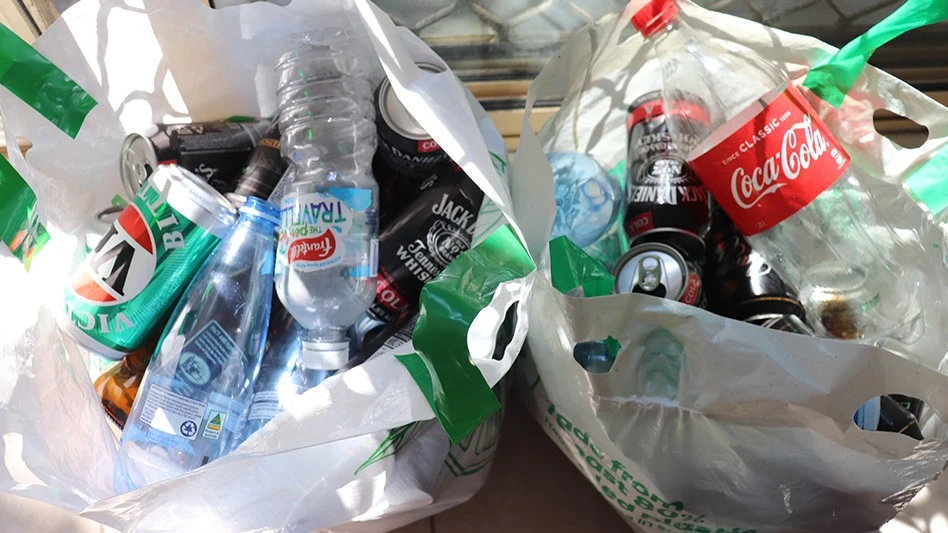
Recycling Today archive
The California Department of Resources Recycling and Recovery (CalRecycle), Sacramento, has released the results of a yearlong study it conducted in 2021 analyzing that state's disposal habits.
The study found that California’s 39.3 million residents and 1.7 million businesses generated an estimated 76.7 million tons of material in 2021 compared with 77.4 million tons in 2020. Based on data reported to CalRecycle, overall disposal in 2021 totaled about 46 million tons compared with 44.9 million tons in 2020.
Additionally, based on calculations and comparison with reported disposal, the department estimates that 30.7 million tons were recycled in 2021. California’s statewide recycling rate was 40 percent, a 2 percent decrease from the previous year. The report says this is from unrecyclable product designs, a lack of international interest in recyclable materials and a constant stream of new single-use products, packaging and materials.
“At this particular point in time, it's hard to pinpoint what consumer behaviors or what behaviors overall led to the data that we received, knowing that we were working through a pandemic,” says Rachel Machi Wagoner, director of CalRecycle.
Organics, paper and plastic are among California's most landfilled materials. However, in 2021, Californians disposed of 11.3 million tons of organic material compared with 13.3 million tons in 2018.
Packaging makes up about 25 percent of what is thrown away in California annually.
Machi Wagoner says these data support the need for more public and private investments and partnerships between the public and private spheres, to build out infrastructure and target those areas of improvement.
CalRecycle says the state is building a circular economy that mines trash for raw materials instead of mining from the planet. The organization’s mission is to:
- introduce an economy where products are designed for reuse;
- have all materials sold in California get recycled and remanufactured in-state; and
- have government and businesses work together to support new markets and industries and more.
This year, 10 bills have been passed that are intended to boost the circular economy and create new opportunities for businesses in the state, including S.B. 1013, S.B. 1215, A.B. 2440 and S.B. 54, among others.
S.B. 1013 redefines “beverage” under the state's bottle bill to include distilled spirits, wine or wine from which alcohol has been removed in whole or in part, including sparkling or carbonated versions. It requires distributors to pay a redemption payment for every beverage container sold or offered for sale in the state of 5 cents for those with a capacity of less than 24 fluid ounces and 10 cents for those with a capacity of 24 fluid ounces or more to CalRecycle and requires the department to deposit the funds into the California Beverage Container Recycling Fund.
The law also requires those beverage containers to have a refund value of 5 cents and 10 cents, respectively, and to contain specified amounts of postconsumer recycled plastic content annually. The bill requires wine or distilled spirits packaged in a box, bladder, pouch or similar container to have a redemption payment and refund value of 25 cents and would grant an additional two years to comply with the act’s postconsumer recycled plastic content requirements.
S.B. 1215 adds battery-embedded products to the Electronic Waste Recycling Act of 2003, expanding the program to cover new and refurbished products with nonremovable batteries and establishing an advanced disposal fee that consumers will pay beginning Jan. 1, 2026. Beginning Aug. 1, 2028, CalRecycle, in collaboration with the Department of Toxic Substances Control, could establish more than one covered electronic waste recycling fee for covered battery-embedded products based on the categories of those products. The charge would be adjusted annually based on the California Consumer Price Index.
A.B. 2440 establishes a manufacturer-run stewardship program for alkaline and rechargeable batteries and requires all retail chains that sell batteries to provide free collection for consumers.
S.B. 54 requires ensuring 100 percent of packaging is recyclable/compostable and 65 percent is recycled by 2032. Specifically, the bill requires disposal facility operators to submit information to the department on the disposal tonnages that are processed at the disposal facility and requires solid waste handlers and transfer station operators to provide information to disposal facility operators for purposes of that requirement. The law requires recycling and composting operations and facilities to submit periodic information to the department on the types and quantities of materials that are disposed of, sold or transferred to other recycling or composting facilities or specified entities.
Machi Wagoner says these new laws have the potential to change markets and the way manufacturers think about their products. The goal is to drive new opportunities around both recycling and remanufacturing and how products are designed in the first place.
“I'm very optimistic because we're out in front of this a little bit,” Machi Wagoner says. “What we need to do is figure out where are the gaps that we can fill with our reform, and that's the focus for us.”
Latest from Waste Today
- CBI introduces new horizontal grinder model
- Closed Loop Partners receives investment
- Fornnax breaks ground on manufacturing facility
- Meridian contributes to vocational education scholarship fund
- MH Equipment recognized as MVP
- Machinex develops Montreal-Est MRF in collaboration with Éco Entreprises Québec
- Liebherr appoints managing director of Liebherr USA Co.
- Michigan governor proposes increased waste disposal surcharge





